

11/2005
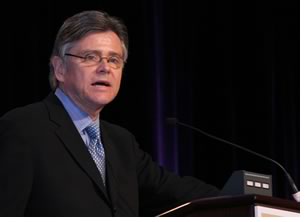 AIA
Vice President for Government Advocacy Ron Faucheux moderated the congressional
panel discussion during the LRRC November 11 lunchtime session. “You
can’t understand it until you see it,” Faucheux said, referring
to the unspeakable destruction that has befallen this region. “A
lot of people whom we need help from haven’t seen it. Therefore,
it’s very important that Louisiana speaks with one voice. Never
has the congressional delegation in Washington been more important.”
AIA
Vice President for Government Advocacy Ron Faucheux moderated the congressional
panel discussion during the LRRC November 11 lunchtime session. “You
can’t understand it until you see it,” Faucheux said, referring
to the unspeakable destruction that has befallen this region. “A
lot of people whom we need help from haven’t seen it. Therefore,
it’s very important that Louisiana speaks with one voice. Never
has the congressional delegation in Washington been more important.”
Keep what is great and embrace change
Senator Mary Landrieu kicked off the session, expressing her thanks to
all who were taking part in “something that is going to be truly
great.” Landrieu couched the conference as a “great opportunity
to share our thoughts” and reminded the participants that as
far as rebuilding goes, it’s not a matter of if, but when and
how. “We are blessed that the stars are now aligned,” she
said, and Louisiana is lucky to have its representatives—including
AIA Executive Vice President/CEO Norman Koonce, FAIA; Ron Faucheux,
a former Louisiana state legislator and secretary of commerce; and
APA President Paul Farmer—in power to get the job done. “We
should take our leadership role to heart,” she said.
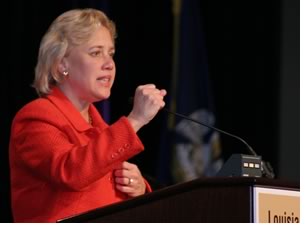 New Orleans and the coastal region originally was a blueprint for urban
design that goes back 300 years, the senator explained. New Orleans didn’t
become a great port, and Jackson Square and the French Quarter weren’t
located to survive great storms by accident. “Our forefathers selected
the location and gave it the care it needed to survive,” she said. “We
built on the legacy of Thomas Jefferson when he made the Louisiana Purchase.
We all came here for a purpose and we all built a great and magnificent
place. Landrieu acknowledged that “we have our problems, but we
will continue to move forward together. We have our challenges but they
will be overcome”
New Orleans and the coastal region originally was a blueprint for urban
design that goes back 300 years, the senator explained. New Orleans didn’t
become a great port, and Jackson Square and the French Quarter weren’t
located to survive great storms by accident. “Our forefathers selected
the location and gave it the care it needed to survive,” she said. “We
built on the legacy of Thomas Jefferson when he made the Louisiana Purchase.
We all came here for a purpose and we all built a great and magnificent
place. Landrieu acknowledged that “we have our problems, but we
will continue to move forward together. We have our challenges but they
will be overcome”
The senator offered five keys for the rebuilding:
- Protection: We must build a state-of-the-art hurricane prevention system capable of withstanding a Category 5 storm. The levees will work more efficiently when wetlands are restored, she reminded participants. We have got to get the federal government to provide a direct stream of funding, she said. “The river belongs to everyone—Louisiana and the region can’t bear the cost alone.”
- Education. We understand that our future is education and we’re going to build an education system second to none, Landrieu declared. “We need to keep a sparkle in our children’s eyes.”
- Housing. Housing, Housing. We have to secure housing and make sure our neighborhoods work.
- Health care. New Orleans was growing to be a health-center before the hurricane, and we must restore that service. “We can’t lose our doctors and nurses,” Landrieu said. “Without health care, our people can’t come back.”
- Small business: We need to focus on the 81,000 businesses that have been hurt or suffered a loss.
“Our spirit will lift us up,” Landrieu concluded. “Regional differences must be put aside. Our diversity is our strength.” The senator asked the participants to keep the focus on reform and “realize that we have to do things differently. Let’s keep what was great and embrace the change,” she said. “Let our children and grandchildren say that we stepped up and got the job done.”
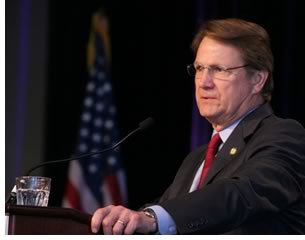 “We’re a working coast”
“We’re a working coast”
Congressman Charles Melançon reminded the participants that this
region “is a working coast, not a resort area, and we can’t
take away the character of the region . . . Planning has to be more
than planning of the city and the region,” he said. “It has
to be about repairing the environmental damage that we have done to our
own land.” The region provides a third of the seafood and a quarter
of the oil and gas to this country, “and no one seems to hear us,” he
said. “I haven’t seen anything of significance coming from
the White House.”
“Together we can move on with our lives,” Melançon concluded. However, the region needs a helping hand from the federal government. The congressman cited examples from the past—among them, New York City after the terrorist attacks of 2001, the San Francisco area after the 1989 Loma Prieta earthquakes, and the Midwest after floods. If the federal government can help these cities without blinking an eye, “then surely the government can help one of the oldest and the finest cities in the country,” Melançon said.
It will be rebuilt—will it be better?
Congressman Bill Jefferson acknowledged that New Orleans and the rest
of the region will emerge from this disaster, “but will it be
better?” he asked. This is our challenge, he told the participants.
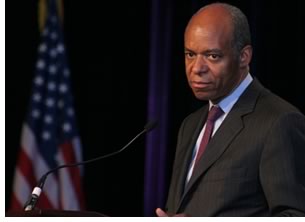 The loss fell disproportionately on the disadvantaged, people who already
were struggling, Jefferson said. “We’ve lost 228,000 housing
units in New Orleans. Our revenue base is decimated. Our goal should
not be to recover, but to transform: We should have a social revolution,” he
declared. The congressman pointed to four main concepts for the rebuilding:
The loss fell disproportionately on the disadvantaged, people who already
were struggling, Jefferson said. “We’ve lost 228,000 housing
units in New Orleans. Our revenue base is decimated. Our goal should
not be to recover, but to transform: We should have a social revolution,” he
declared. The congressman pointed to four main concepts for the rebuilding:
- We must recreate a region that is survivable for the long term by incorporating Category 5 hurricanes protection. “The hurricanes told us that we cannot rely only on seawall protection. We need guidance from experts, and we need a transparent planning process with life-cycle-cost analysis.”
- We need high-quality, sustainable development.
- Neighborhoods of choice must replace neighborhoods of poverty.
- We have to make the change to a high-paid workforce.
All this will require a sustained vision over many years in New Orleans, the Gulf Coast region, and on Capitol Hill, Jefferson said. He is confident that we can rebuild in this way. “Never before has the nation needed you more,” he told the audience.
Setting priorities
Congressman Bobby Jindal offered the audience three sets of priorities:
process, priorities that require federal help, and ongoing priorities.
Process priorities
- We need to set priorities.
- We need to speak with one voice about rebuilding New Orleans and Louisiana.
- We have to keep demonstrating that we as a state will do our part in the rebuilding process.
Priorities that require federal help:
- Category 5-level coastal protection. “We generate $5-6 billion for the rest of the country each year. The coast needs to be protected,” Jindal said.
- Jobs. Jobs. Jobs. The more quickly we rebuild our economy, the more quickly we can rebuild our region. We need to make it attractive for businesses to come back, and that includes incentives such as Small Business Association loans and tax incentives.
- Affordable insurance. “We have tens of thousands who have paid their flood insurance and paid their taxes who are now being told they aren’t covered. We need to make it affordable for people to come back,” Jindal said.
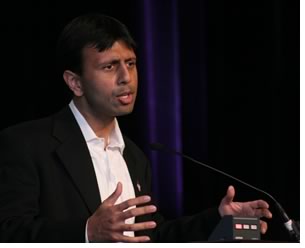 Ongoing priorities
Ongoing priorities
Jindal’s last three priorities are those that were challenges
to the area before the storms and are even bigger challenges now:
Education. We owe the gift of the best education possible to every student
in Louisiana. Look for bipartisan support to help children in whichever
schools they attend, as well as research programs in universities
Housing. We trap people in multi-generational “prisons,” Jindal
said. “Let’s create better housing.”
Health care. Our health system
is grossly outdated, according to Jindal. We force people into emergency
care because we don’t have electronic
records, and sick people get sicker because they don’t get the
care that they need. “Let’s create a first-class health-care
system that is the envy of the world,” he said.
Jindal led Veteran’s Day applause to thank our men and women in uniform. “After Katrina, we saw good reason for why we consider them such heroes,” he said. In parting, he concluded, “Shame on us if we don’t choose to build an even better Louisiana.”
Copyright 2005 The American Institute of Architects.
All rights reserved. Home Page ![]()
![]()
 |
||
Read
coverage of the LRRC in the New Orlean’s Gambit.
|
||